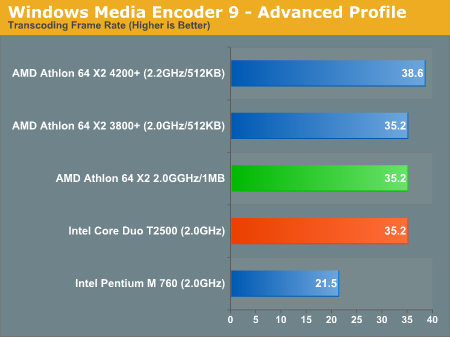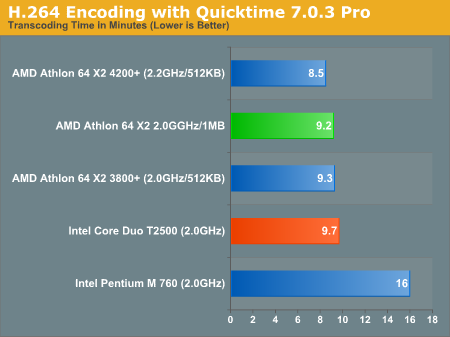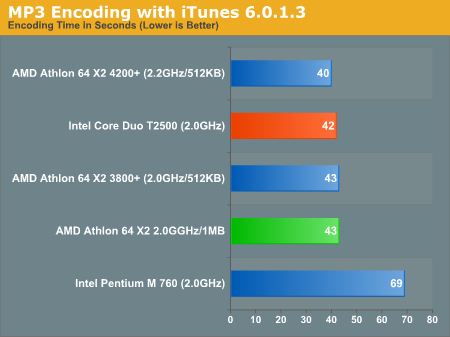Intel Core Duo (Yonah) Performance Preview - Part II
by Anand Lal Shimpi on December 19, 2005 12:55 PM EST- Posted in
- CPUs
Media Encoding Performance with DVD Shrink, WME, Quicktime and iTunes
We were most curious about the Core Duo's media encoding performance, given that a number of the optimizations for the new processor were FP/SSE related. We've updated our entire media encoding test suite, including everything from the one-click DVD ripping utility DVD Shrink to including H.264 encoding performance with Quicktime 7.0.3 Pro. We wanted to include the latest version of DivX in this comparison. However, the recent release of DivX 6.1 left us with a few bugs that we're still trying to work out in our test beds, so we had to exclude it. However, as time goes on, H.264 encoding will quickly become far more important than even looking at DivX, so its omission from this article isn't as big of a loss in terms of forward-looking performance.
First up is DVD Shrink 3.2.0.15. Our test was simple - we took a copy of Star Wars Episode VI and ripped the full DVD to the hard drive without compression, effectively giving us an exact copy of the disc on the hard drive. Then, using the copy of the DVD on the hard drive (to eliminate any DVD drive bottlenecks), we performed a DVD shrink operation to shrink the movie to fit on a single 4.5GB DVD disc. All of the options were left on their defaults, so the test ends up being pretty easy to run and reproduce. The scores reported are DVD encoding times in minutes, with lower numbers meaning better performance.
The DVD Shrink test is quite important as DVD Shrink is quite possibly one of the easiest tools to rip a DVD. The easier a tool is to use, the more likely it's going to be used, and arguably the more important performance using it happens to be.
Moving on, we have our Windows Media Encoder 9 test, which uses the advanced profile settings for video encoding. We left all settings at their defaults and just proceeded with a MPEG-2 to WMV-HD conversion. The values reported are in frames per second, with higher numbers being better.
Next up, we have Quicktime Pro 7.0.3 and we perform a MPEG-2 to H.264 encoding task. All of the settings are left at their defaults, with the exception that we optimize the output file for download with a 256kbps data rate while leaving the resolution untouched. We also adjust the video options to optimize for the best quality. We report the transcoding time in minutes, with lower values being better.
Finally, we have a MP3 encoding test using iTunes 6.0.1.3. For this test, we simply took a 304MB wav file and converted it to a 192kbps MP3 file, measuring the encode time in seconds. The only iTunes option that we changed was to prevent the playback of the song while encoding.
We were most curious about the Core Duo's media encoding performance, given that a number of the optimizations for the new processor were FP/SSE related. We've updated our entire media encoding test suite, including everything from the one-click DVD ripping utility DVD Shrink to including H.264 encoding performance with Quicktime 7.0.3 Pro. We wanted to include the latest version of DivX in this comparison. However, the recent release of DivX 6.1 left us with a few bugs that we're still trying to work out in our test beds, so we had to exclude it. However, as time goes on, H.264 encoding will quickly become far more important than even looking at DivX, so its omission from this article isn't as big of a loss in terms of forward-looking performance.
First up is DVD Shrink 3.2.0.15. Our test was simple - we took a copy of Star Wars Episode VI and ripped the full DVD to the hard drive without compression, effectively giving us an exact copy of the disc on the hard drive. Then, using the copy of the DVD on the hard drive (to eliminate any DVD drive bottlenecks), we performed a DVD shrink operation to shrink the movie to fit on a single 4.5GB DVD disc. All of the options were left on their defaults, so the test ends up being pretty easy to run and reproduce. The scores reported are DVD encoding times in minutes, with lower numbers meaning better performance.
The DVD Shrink test is quite important as DVD Shrink is quite possibly one of the easiest tools to rip a DVD. The easier a tool is to use, the more likely it's going to be used, and arguably the more important performance using it happens to be.

- The Pentium M performs exceptionally poorly, and
- The Core Duo performs exceptionally well.
Moving on, we have our Windows Media Encoder 9 test, which uses the advanced profile settings for video encoding. We left all settings at their defaults and just proceeded with a MPEG-2 to WMV-HD conversion. The values reported are in frames per second, with higher numbers being better.

Next up, we have Quicktime Pro 7.0.3 and we perform a MPEG-2 to H.264 encoding task. All of the settings are left at their defaults, with the exception that we optimize the output file for download with a 256kbps data rate while leaving the resolution untouched. We also adjust the video options to optimize for the best quality. We report the transcoding time in minutes, with lower values being better.

Finally, we have a MP3 encoding test using iTunes 6.0.1.3. For this test, we simply took a 304MB wav file and converted it to a 192kbps MP3 file, measuring the encode time in seconds. The only iTunes option that we changed was to prevent the playback of the song while encoding.

Professional Application Performance with 3dsmax, Adobe Premier and Photoshop
Gaming Performance with Battlefield 2 and Black & White 2










103 Comments
View All Comments
mitcoes - Saturday, April 22, 2006 - link
The msot important question about corel duo, is if dual processors Apple Machines with ATI X1900XT woul be a better machine than AMD and Pentium with one processor at same clocks. Better when core duo would arrive to 3 Mhz or nearby. Becouse hard gamers, and renderers would buy this (expending a few more bucks) and have the choice of use MAC OS, Win XP, an Linux on the same machine with opengl games probably going better in Leopard than in XP becouse of the better networking of UNIX and Linux over TCP/IP. The test of packets losed with Quake3 XP vs Leopard would be a great test, becouse probably AMD, and Pentium with same clocks and ATI would have similar preformance in games that are not prepared for two processors, but Photoshop CS2, blender And other CAD/CAM apps would run better. Perhaps The future new market of Apple machines are hard gamers, and hard users like architects, renderers, animators and so one. But it must be tested. And I want to know if MAC mainboards are better than ASUS and Gigabyte ones (or other better if them exists).Cygni - Wednesday, December 21, 2005 - link
Congrat AT commenters! I have to say, this is the new HIGH SCORE for useless, incorrect, biased, self important posts in the history of AT!Really, i was going to respond to each one in turn, but I think its far easier just to make this one post where i point out that many, many, many of you should likely try lurking a bit instead of instantly hitting the reply button and spouting off about latencys, bus widths, and other thing your Toms Hardware Education degree has certified you an expert at. We will all be more intelligent if you didnt post.
IntelUser2000 - Tuesday, December 20, 2005 - link
They should have used low latency DDR2-533 rather than the normal JEDEC specified 4-4-4-12 latency for their reviews. It might be faster then :)).Also, testing Sonoma notebooks have shown that it likes single channel DDR2-533 better than DDR2-400, like how it doesn't benefit from dual channel. I would also like to see DDR2-667 results(over dual channel DDR2-533), as few % here and there will really show Yonah's potential.
coldpower27 - Tuesday, December 20, 2005 - link
Yes that would be interesting, as Anantech does have Corsair DDR2-667 3-2-2-8 available in their repitoire.StuckMojo - Tuesday, December 20, 2005 - link
I'd like to see compilation benchmarks. Lots of us use our laptops for software development.
Betwon - Tuesday, December 20, 2005 - link
Compilation?At the recent Spec CPU Cint2000 test--The most fast x86 CPU about compiler is P4 670.
176.gcc 2195/2195 ponits
PM@2.26GHz(1995/1994) is fast than FX-55@2.6GHz(1931/1933).
IntelUser2000 - Tuesday, December 20, 2005 - link
If any of you actually care to search for transistor performance of Intel's and AMD/IBM, you can see that AMD/IBM's the newest 65nm process is only 2-3% faster but Intel is providing the numbers at HALF the leakage.There WILL be X2 clock speed like versions of Yonah with higher TDP and being graded as EE.
-Equal platform comparisons are never possible.
-DDR2's power advantage isn't as great as you think.
-We don't know if Turion would benefit at all from DDR2 in performance, the claimed 15% or so is at best case, aka single benchmark. It always happens, companies say some wonder number and in reality its even worse than the previous one.
Betwon - Tuesday, December 20, 2005 - link
The very low latency of L2 cache is the main real reason? AT may be foreget that L2 can be shared, which is different with AMD.Schmide - Tuesday, December 20, 2005 - link
Correct me if I'm wrong. Doesn't the AMD architecture have a 3 cycle L1 latency due to an exclusive L1 L2 cache relationship. While Intel uses a 2 cycle L1 inclusive L1 L2 cache relationship. With the larger cache sizes now, the more costly exclusive set seems to be holding AMD back. However, this higher latency could be the reason AMD is able to reach higher speeds using a lower process.As for the power consumption, I wonder if the board design had anything to do with the X2 being 30% higher. Chime in here
On die memory controller advantage AMD.
DDR2 lower power consumption advantage Intel
65nm process advantage Intel
Mature SOI advantage AMD.
Betwon - Tuesday, December 20, 2005 - link
You are wrong about the cache of Yonah. The mobile CPU is different with the Netburst.Yonah's L1 latency is 3 cycles, and it is a kind of write-back cache, which needs not always copy the data to L2. L2 latency is 14 cycles(AT said), which is the same with AthonX2. And Yonah's number of pipeline stages is 11,12, or 13. The AthonX2 is 12-stage. So, (Include AT)we believe that Yonah can reach the high frequency. The real reason of Yonah only max 2.16GHz -- for the moblie applications ... to control the power sum.